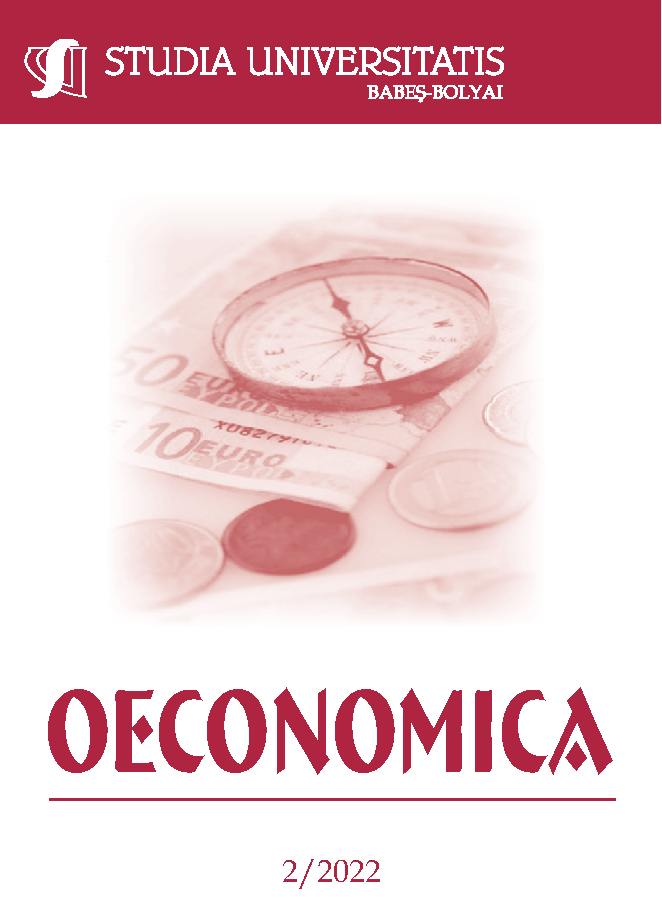THE IMPACT OF ACCESS TO CREDIT ON WELFARE INEQUALITY IN MALAWI
DOI:
https://doi.org/10.2478/SUBBOEC-2022-0009Keywords:
access to credit; Households; inequality; Theil index; Lorenzo curve. IHS2017Abstract
This study evaluates the implications that access to credit has on welfare inequality in Malawi in order to address the gap left in previous studies concerning credit. The study employed data from Malawi’s Integrated Household Survey 2017 and used the propensity score analysis to examine what impact access to credit may have on the welfare of Malawian households using consumption per capita as a proxy for household welfare. The study further proceeded to use the generalized Lorenz curve, the Theil indexes as well as the Gini to examine the inequalities present in welfare among the households that access credit and those that do not. The results showed a positive impact of access to credit on welfare as households with access to credit experience lower levels of inequality than those without. However, a closer examination of the Theil’s indexes found that factors unrelated to access to credit had a stronger effect on inter-household inequalities than access to credit. The results imply that the impact that access to credit has on welfare inequality is a positive one, but its effect is substantially small. Thus, implying that policies aimed at enhancing distribution of credit should continue. Simultaneously, a more holistic approach on reducing inequality should be included at both household level and national level to achieve a desired result.
JEL classification: I390
References
Adebowale, O., & Dimova, R. (2017). Does Access to Formal Finance Matter for Welfare and Inequality? Micro Level Evidence from Nigeria (No. 007; Manchester 1824).
Angrist, J. D. (2008). Treatment Effect. In https://Economics.Mit.Edu/Files.
Attanasio, O. P., & Pistaferri, L. (2016). Consumption Inequality. Journal of Economic Perspectives, 30(2).
Austin, P. C. (2011). An Introduction to Propensity Score Methods for Reducing the Effects of Confounding in Observational Studies. Multivariate Behavioral Research, 46(3).
Barroso, A. (2022). What Is Credit and Why Do You Need It? https://www.nerdwallet.com/article/finace/what-is-credit
Centeno, R. V. F. (2021). Amartya Sen’s Capability Theory Approach.
Chowdhury, M. J. A., Ghosh, D., & Wright, R. E. (2005). The Impact of Micro-Credit on Poverty: Evidence from Bangladesh. Progress in Development Studies, 5(4).
Corak, M. (2013). Public Policies for Equality and Social Mobility in Canada: A Background Paper Prepared for The Canada 2020 Event Equality of Opportunity – A Canadian Dream? Canada 2020.Ca.
Delis, M., Fringuellotti, F., & Ongena, S. (2021). Credit, Income, And Inequality. https://www.newyorkfed.org/medialibrary/media/research/staffreports/sr929.pdf
Demirgüç-Kunt, A., & Levine, R. (2009). Finance and Inequality: Theory and Evidence. Annual Review of Financial Economics, 1(1).
Diagne, A. (1998). Impact of Access to Credit on Income and Food Security in Malawi (No. 46; Food Consumption and Nutrition Division).
Diagne, A., & Zeller, M. (2001). Access to Credit and Its Impact on Welfare in Malawi.
Gambetta, N., Azcárate-Llanes, F., Sierra-García, L., & García-Benau, M. A. (2021). Financial Institutions’ Risk Profile and Contribution to The Sustainable Development Goals. Sustainability, 13(14). https://doi.org/10.3390/su13147738
Government of Malawi. (2012). National Social Support Policy. Government of Malawi.
Greve, B. (2008). What Is Welfare? Central European Journal of Public Policy, 2(1).
Haughton, J., & Khandker, S. R. (2009). Handbook On Poverty and Inequality. The World Bank Group.
Hone, Z., & Marisennayya, S. (2019). Determinants of Household Consumption Expenditure in Debremarkos Town, Amhara Region, Ethiopia. American Scientific Research Journal for Engineering, Technology, And Sciences (Asrjets), 62(1), 124–144.
Kling, G., Pesqué-Cela, V., Tian, L., & Luo, D. (2020). A Theory of Financial Inclusion and Income Inequality. The European Journal of Finance. https://doi.org/10.1080/1351847x.2020.1792960
Kwengwere, P. (2011). Inequality in Malawi. In Tearing Us Apart: Inequalities in Southern Africa (Pp. 122–179).
Matita, M. M., & Chirwa, E. W. (2009). Rural - Urban Welfare Inequalities in Malawi: Evidence from A Decomposition Analysis (2009/05).
Mussa, R., & Masanjala, W. (2015). A Dangerous Divide: The State of Inequality in Malawi. Oxfam International.
National Statistical Office. (2005). Integrated Household Survey 2004-2005. O.
National Statistical Office. (2012). Integrated Household Survey 2010-2011: Household Socio-Economic Characteristics Report.
Nguyen, T.-T., Nguyen, T. T., & Grote, U. (2020). Credit and Ethnic Consumption Inequality in The Central Highlands of Vietnam. Social Indicators Research, 148(1).
Notes On Formal and Informal Credit - Cbse Class 10 Economics. (N.D.). https://www.nextgurukul.in/wiki/concept/cbse/class-10/economics/money-and-credit/formal-and-informal-credit/3959959
Ozili, P. K. (2020). Theories of Financial Inclusion. SSRN Electronic Journal. https://doi.org/10.2139/ssrn.3526548
Ragan, C. T. S., & Lipsey, R. G. (2011). Economics (13th Ed.). Pearson Education Canada.
Sebu, J. (2017). Essays On Farm Household Credit Constraint, Productivity and Consumption Inequality in Malawi [Phd]. University of Kent.
Sen, A. (1993). Capability and well-being. In Martha Nussbaum & Amartya Sen (Eds.), Quality of Life (pp. 30-53). Oxford: Clarendon Press.
Todaro, M. P., & Smith, S. C. (2009). Economic Development. Pearson Addison Wesley.
United Nations. (2015). Development Issues No. 1: Concepts of Inequality. United Nations
United Nations. (2018). The Sustainable Development Goals Report 2018. https://unstats.un.org/sdgs/files/report/2018/thesustainabledevelopmentgoalsreport2018-en.pdf
United Nations. (2021). The Sustainable Development Goals.https://unstats.un.org/sdgs/files/report/2018/thesustainabledevelopmentgoalsreport2018-en.pdf
Van De Meerendonk, A. (2016). Assessment of social protection programmes and costing of policy options. https://www.ilo.org/wcmsp5/groups/public/-africa/ro-abidjan/ilo-lusaka/documents/publication/wcms_493917.pdf
Vellucci, P. (2021). A Critique of Financial Neoliberalism: A Perspective Combining Multidisciplinary Methods and Commodity Markets. SN Business & Economics, 1(3).
World Bank. (2021a). Malawi - Fifth Integrated Household Survey 2019-2020.
World Bank. (2021b). Understanding Poverty: Financial Inclusion.
Downloads
Published
How to Cite
Issue
Section
License
Copyright (c) 2022 Studia Universitatis Babeș-Bolyai Oeconomica

This work is licensed under a Creative Commons Attribution-NonCommercial-NoDerivatives 4.0 International License.



